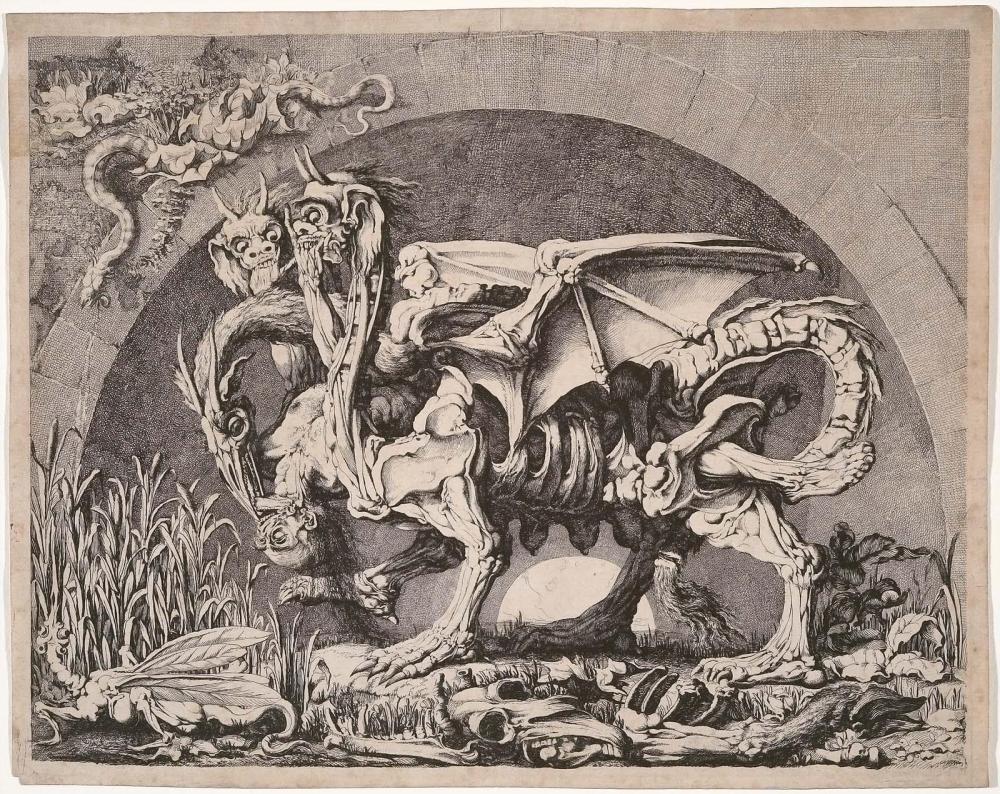Advanced Search 

The Chimera
Louis-Jean Desprez (French, 1743–1804)
1777–84
Medium/Technique
Etching
Dimensions
Platemark: 27.6 × 35.7 cm (10 7/8 × 14 1/16 in.)
Sheet: 29.4 × 37.4 cm (11 9/16 × 14 3/4 in.)
Sheet: 29.4 × 37.4 cm (11 9/16 × 14 3/4 in.)
Credit Line
Katherine E. Bullard Fund in memory of Francis Bullard
Accession Number2006.845
NOT ON VIEW
CollectionsEurope, Prints and Drawings
ClassificationsPrints
Desprez was born in the Burgundian town of Auxerre. He studied architecture and won the Prix de Rome in 1776. He left for Italy the following year and remained there until 1784. During his stay Desprez's interests shifted somewhat from architecture to architectural draftsmanship and illustration. His operatic flair is evident in "The Capture and Burning of Selinus by Hannibal" of 1783-84. Shortly after he made that dramatic etching, King Gustav III summoned him to Stockholm to lead his staff of set designers. Within four years, Gustav appointed him principal architect to the Crown.
The fifth state of the print bears an inscription describing the subject. Victor Carlson transliterated it as follows:
"The beast, born in the burning sands of Africa, lived in the ruined palace once belonging to Masinissa (ca. 240-148 B.C.), the former ruler of Numidia, a retreat which the chimera left only to devour animals and unwary travelers. Neither land nor sea could contain the monster, who moved ceaselessly over both in his unending hunt. Here, a blazing sun and an arch describe the chimera's African habitat; the ground is crawling with reptiles and strewn with the remains of victims."
The Eighteenth Century is often characterized as celebrating frivolous indulgence and military valor; yet, it was also an age that ventured into the terrifying darkness of the sublime. Desprez collaborated with Francesco Piranesi and was clearly familiar with the work of his father, Giovanni Battista Piranesi, whose architectural fantasies provided the model for the chimera's home. The elder Piranesi's prisons also crystallized the zeitgeist that Desprez here reinterprets in bizarre figural form.
"The Chimera" bears a lightly scratched inscription, faint to the limits of legibility, apparently reading "desprez del Rom." This places the etching sometime between 1777 and 1784.
The fifth state of the print bears an inscription describing the subject. Victor Carlson transliterated it as follows:
"The beast, born in the burning sands of Africa, lived in the ruined palace once belonging to Masinissa (ca. 240-148 B.C.), the former ruler of Numidia, a retreat which the chimera left only to devour animals and unwary travelers. Neither land nor sea could contain the monster, who moved ceaselessly over both in his unending hunt. Here, a blazing sun and an arch describe the chimera's African habitat; the ground is crawling with reptiles and strewn with the remains of victims."
The Eighteenth Century is often characterized as celebrating frivolous indulgence and military valor; yet, it was also an age that ventured into the terrifying darkness of the sublime. Desprez collaborated with Francesco Piranesi and was clearly familiar with the work of his father, Giovanni Battista Piranesi, whose architectural fantasies provided the model for the chimera's home. The elder Piranesi's prisons also crystallized the zeitgeist that Desprez here reinterprets in bizarre figural form.
"The Chimera" bears a lightly scratched inscription, faint to the limits of legibility, apparently reading "desprez del Rom." This places the etching sometime between 1777 and 1784.
Catalogue Raisonné
Baudicour 6, state 1
State
i/v
InscriptionsLightly scratched in plate at lower left corner: desprez del Rom
Verso upper edge in graphite pencil: [unclear inscription]
Verso right in graphite pencil: 4297
Verso upper edge in graphite pencil: [unclear inscription]
Verso right in graphite pencil: 4297
ProvenanceNovember 23, 2005, anonymous sale, Daguerre (in association with Brissonneau and Hotel Drouot), Paris, to Hill-Stone, Inc., New York; 2006, sold by Hill-Stone to the MFA. (Accession Date: March 22, 2006)
